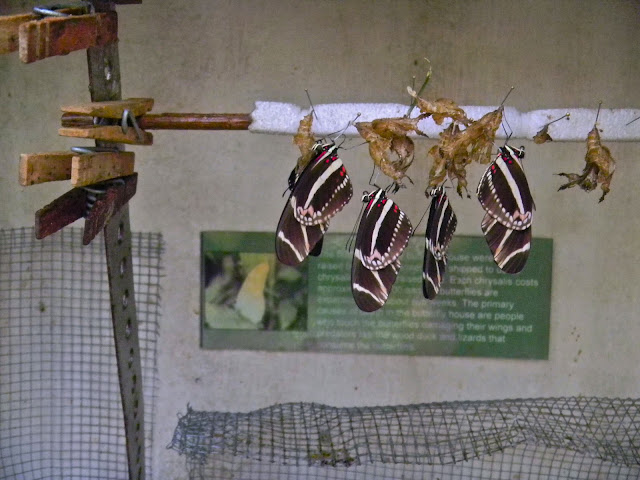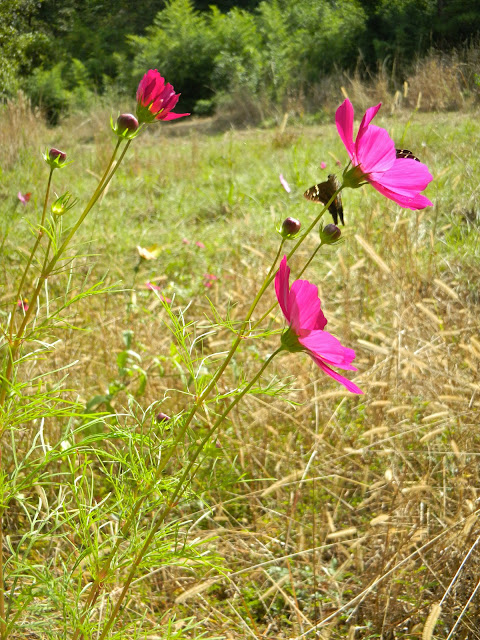 |
| An aging Gulf Fritillary rests on a zinnia Cypress Gardens in Berkeley County, South Carolina
Here's where I admit that I'm not a great butterfly photographer. Even if I had a more professional camera and a high quality macro lens, I wouldn't be a great butterfly photographer. These most beautiful of insects habitually flit away before I can focus or, if I'm lucky enough to focus, they take off just as I depress the shutter. Countless times I end up with a blur of motion smeared across the frame. Also, often when butterflies are out feeding, the sun is bearing down, creating too much contrast, bleaching color from blossoms and leaves. Such difficulties don't stop me from trying, yet for every decent butterfly photograph I've ever taken, there must be at least half a dozen that are embarrassingly inadequate.
These days I use digital cameras and don't have to worry about the cost of each attempt. Back when I used a film camera, an SLR, I once dedicated an entire roll of film to trying to capture the various species of butterflies on the family farm in Northeastern North Carolina. The results? Costly and disheartening.
During my only summer visit to Japan, I never did manage to satisfactorily capture the Blue Triangle butterfly on a memory card. The one above is sadly out of focus.
But occasionally I manage a shot I'm pleased with. This one that I took of a Gulf Fritillary last week, with a new point and shoot camera, rivals any I've taken with an SLR or DSLR over the years. A tad bit too much sun perhaps, but....
|
 |
| Gulf Fritillary sipping nectar from a lantana in my front yard |
So what plants attract butterflies?
Butterflies need both host plants and nectar plants. The preferred host varies by species. Monarchs lay their eggs on milkweed. Some of the skippers use oak trees as hosts. Others use wisteria, members of the pea family, amaranth, cockscomb, or hollyhocks. Some swallowtails use Queen Anne's Lace and related plants. Others use magnolias. Many of the sulphurs prefer legumes as hosts. Gulf Fritillary prefer passion vines. (Perhaps this explains why I see so many Gulf Fritillaries in my yard - each year caterpillars devour the leaves of my passion flower.)
As with host plants, different butterfly species have different preferences for nectar. Here's what I'm seeing in my own garden: The Gulf Fritillaries sip nectar from any one of the three varieties of lantana I grow. Until the last blooms dropped from my red cannas earlier this month, the Cloudless Sulphur could be seen feeding there regularly, holding their wings together, flattening themselves in such a way that they appeared like bright yellow leaves. The Long-tailed Skippers seem equally happy with zinnia that's growing in a flower bed or lantana or the pot of Sceavola I bought last week.
Just over a week ago I served as a garden docent during the Charleston Horticultural Society's Gardens for Gardeners Tour. The gardens on display during the tour included those of a luxury hotel, The Sanctuary at Kiawah Island.
I regret to report that I have no photographs of The Jasmine Porch butterfly garden at The Sanctuary. When I stopped by on my way to the house to which I had been assigned, I was in a hurry and the sun shown brilliantly. In short, I forgot to pull out my camera. As I recall, the plantings included lantana and various other popular plants that attract butterflies in the South during autumn. What I clearly remember is recognizing a single Ixora coccinea. I recognized this plant because I had recently discovered it on the clearance rack at my favorite local nursery, Abide-A-While, and bought two of these jungle geraniums for my own garden.
I regret to report that I have no photographs of The Jasmine Porch butterfly garden at The Sanctuary. When I stopped by on my way to the house to which I had been assigned, I was in a hurry and the sun shown brilliantly. In short, I forgot to pull out my camera. As I recall, the plantings included lantana and various other popular plants that attract butterflies in the South during autumn. What I clearly remember is recognizing a single Ixora coccinea. I recognized this plant because I had recently discovered it on the clearance rack at my favorite local nursery, Abide-A-While, and bought two of these jungle geraniums for my own garden.
 |
| Ixora coccinea aka jungle geranium |
 |
| Close up of Ixora coccinea |
According to an informational sheet provided by The Sanctuary at Kiawah Island during the tour, the landscaping crew removed nearly all existing plant material from the butterfly garden at the beginning of this year and supplemented the soil with cotton burr compost and other amendments. Each plant in the new design is a known butterfly host or nectar plant.
The Kiawah Island garden is a work in progress. During the year , due to problems with aphids and mealy bugs, the crew removed coreopsis. They also removed agapanthus because it attracted deer.
The Kiawah Island garden is a work in progress. During the year , due to problems with aphids and mealy bugs, the crew removed coreopsis. They also removed agapanthus because it attracted deer.
 |
| Red Admiral in Scotland's Inverewe Gardens To see a larger version of this photograph follow the link: http://gardenvisitor.blogspot.com/2012/08/a-week-in-inverewe-gardens.html |
Inspired by viewing The Sanctuary's butterfly garden, I took a field trip to Berkeley County, South Carolina's Cypress Gardens this past Thursday to visit the butterfly house and garden there. This time I remembered to pull out my camera.
 |
| Gulf Fritillary on Bird of Paradise inside the Butterfly House at Cypress Gardens |
 |
Butterfly Garden outside the Butterfly House at Cypress Gardens
The Butterfly House was staffed by two friendly and knowledgeable volunteers. In addition to butterflies, and host and nectar plants for the butterflies, the building housed a glass beehive, a wood duck, a painted bunting, several red-eyed doves, several small quail, and a pair of turtles.
|
 |
| Emerging from the chrysalis Butterfly House at Cypress Gardens |
 |
| This Julia butterfly blends in Butterfly House, Cypress Gardens |
 |
| Cloudless Sulphur on azalea on an October day Cypress Gardens |
 |
| Gulf Fritillary on pink zinnia at Cypress Gardens |
 |
| Long-tailed skipper on camellia Cypress Gardens |
 |
| Gulf Fritillary feeding on asters at Cypress Gardens |
 | ||||
Inside the Butterfly House at Cypress Gardens
|
| ||
Author Mary Alice Monroe, who often addresses environmental issues in the novels she writes, has written about Monarch migration in The Butterfly's Daughter. Not only did she raise awareness of the Monarch's diminishing habitat, but during a book launch event she gave milkweed seed to readers to help combat that loss. Monarch butterflies also appear in Flight Behavior, Barbara Kingsolver's new novel, which deals with climate change.
|
For more information about Cypress Gardens, visit their website:
 |
| Laying eggs? Gulf Fritillary inside the Butterfly House at South Carolina's Cypress Gardens |






No comments:
Post a Comment